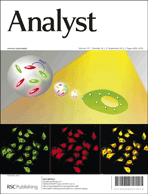Reductive amination of glutaraldehyde 2,4-dinitrophenylhydrazone using 2-picoline borane and high-performance liquid chromatographic analysis
Abstract
A typical method for the measurement of glutaraldehyde (GLA) employs 2,4-dinitrophenylhydrazine (DNPH) to form GLA–DNPhydrazone derivatives. However, this method is subject to analytical errors because GLA–DNPhydrazone is a quaternary bis-derivative and forms three geometric isomers (E–E, E–Z and Z–Z) as a result of the two C![[double bond, length as m-dash]](https://www.rsc.org/images/entities/char_e001.gif) N double bonds. To overcome this issue, a method for transforming the C
N double bonds. To overcome this issue, a method for transforming the C![[double bond, length as m-dash]](https://www.rsc.org/images/entities/char_e001.gif) N double bond into a C–N single bond, using reductive amination of DNPhydrazone derivatives, has been applied. The amination reaction of GLA–DNPhydrazones with 2-picoline borane is accelerated with catalytic amounts of acid and is completed within 10 minutes in the presence of 100 mmol L−1 phosphoric acid. Reduction of GLA–DNPhydrazone by 2-picoline borane is unique and results in the formation of N-(2,4-dinitrophenyl)-1-piperidinamine (DNPPA). NMR and LC-APCI-MS data confirmed the product identification. DNPPA is very stable and did not change when stored for at least four weeks at room temperature. DNPPA has excellent solubility of 14.6 g L−1 at 20 °C in acetonitrile. The absorption maximum wavelength and the molar absorptivity of DNPPA were 351 nm and 4.2 × 104 L mol−1 cm−1 respectively. Complete separation between the reduced forms of C1–C10 aldehyde DNPhydrazones, including DNPPA, can be achieved by operating the reversed-phase high-performance liquid chromatograph at 351 nm in gradient mode using a C18 amide column. The reductive amination method for GLA overcomes analytical errors caused by E–E, E–Z and Z–Z geometrical isomers.
N double bond into a C–N single bond, using reductive amination of DNPhydrazone derivatives, has been applied. The amination reaction of GLA–DNPhydrazones with 2-picoline borane is accelerated with catalytic amounts of acid and is completed within 10 minutes in the presence of 100 mmol L−1 phosphoric acid. Reduction of GLA–DNPhydrazone by 2-picoline borane is unique and results in the formation of N-(2,4-dinitrophenyl)-1-piperidinamine (DNPPA). NMR and LC-APCI-MS data confirmed the product identification. DNPPA is very stable and did not change when stored for at least four weeks at room temperature. DNPPA has excellent solubility of 14.6 g L−1 at 20 °C in acetonitrile. The absorption maximum wavelength and the molar absorptivity of DNPPA were 351 nm and 4.2 × 104 L mol−1 cm−1 respectively. Complete separation between the reduced forms of C1–C10 aldehyde DNPhydrazones, including DNPPA, can be achieved by operating the reversed-phase high-performance liquid chromatograph at 351 nm in gradient mode using a C18 amide column. The reductive amination method for GLA overcomes analytical errors caused by E–E, E–Z and Z–Z geometrical isomers.


 Please wait while we load your content...
Please wait while we load your content...